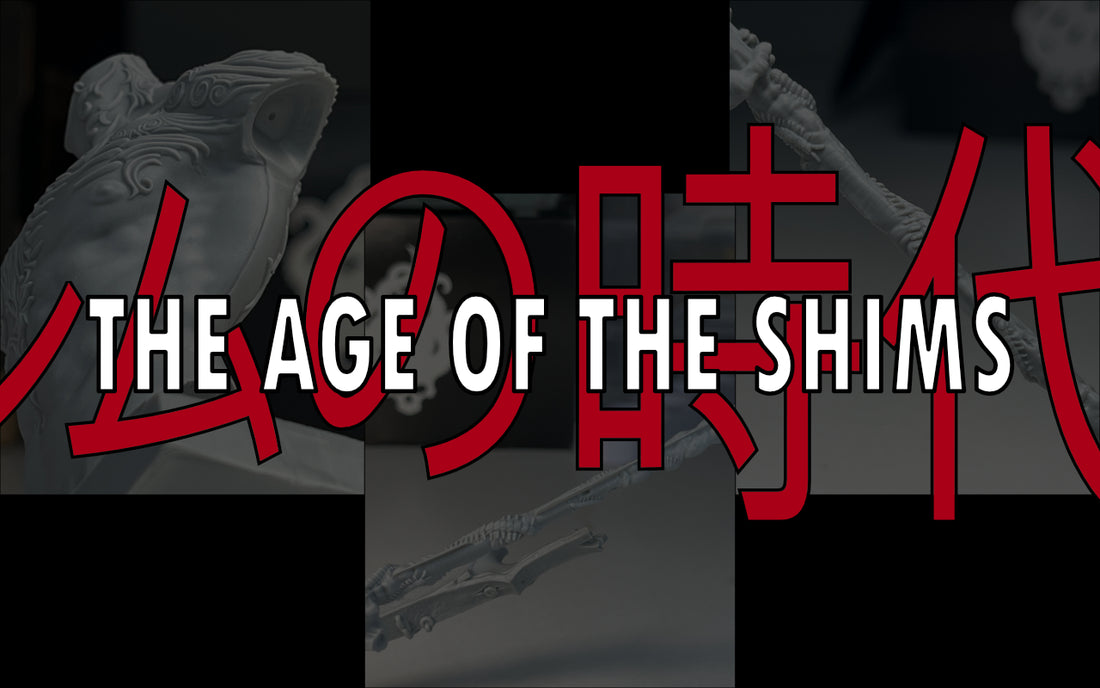This is a condensed version of the article. If you are interested in a detail explanation with more examples please go here.
As the person responsible for the quality of the resin miniatures you receive, I wanted to share a recent change in our work flow to improve the quality of our miniatures by using shims.
What is a shim in the context of resin models? A thin piece of material used to align parts, help remove air, absorb excess pressure and reduce wear.
This may look unsightly upon initial inspection, especially if you are used to our previous models, but in practice this should allow our supporters to obtain a nicer finish.

What are the pros and cons?
- You will benefit the most from this change if you are a hobbyist that cares about mold lines and would like to see Creature Caster do more exotic designs.
- I feel there will be a portion for the hobbyist community that will dislike this change. I would expect people who generally do not clean mold lines (and people who are more focused on playing instead of painting) will find that the work has increased to assemble their models.


It has been a dilemma to decide if we should make this change or go with what we've done in the past. We have mulled over this for many years, wondering if we should make what we believe is a positive change or go with what has been working well enough. Our logic is that our supporters have bought the models as centerpieces and our team wants to provide the experience to best achieve the polished look of a premium model by using our shim technique.
The WHYS.
-
No longer need to sand our miniatures, thus safer
It seems that very few hobbyists sand models and prefer to only use a hobby knife to prep their parts. Shims provide the opportunity to obtain a great finish without having to sand. Sanding releases small particulates into the air which is a health hazard, particularly if proper PPE is not worn. -
Less work for people who care about mold lines
It is easier to remove material than to add material. It saves a lot of time when you don’t have to fill areas where the two halves of the mold come together or shave away material to level the mold line (which can greatly distort the shape of the part). -
Allows us to create evocative designs while keeping the parts to a reasonable quantity
Resin Casting follows certain Design principles. We must follow the Rules of Resin Casting (which we have honed over the years) in order to create quality pieces and consistent molds. Certain shims allow us to circumvent these rules and allow us to make complex models with less parts, sharper points, and deeper undercuts.

-
Shims absorb mold shifts.
A mold shift is caused by a misalignment of the two halves of the mold resulting in a mold line which is difficult to realign with just a knife. Generally you have to fill and sand to obtain a nice finish. Our team makes great efforts to place mold lines on areas which will result in the least amount of cleaning and distortion. However, there are times when there are very few good options but to place the mold line over an area that we would normally like to avoid. The shim over this area will help absorb excess pressure and prevent the model from having a misalignment.

All these efforts are for one primary purpose: you will be proud of the work you put into assembling and painting our range of miniatures and will be able to avoid as many cons of working with resin as possible while enjoying the benefits of striking and life-like details. We are hoping that people will notice the quality ceiling of their finished models will be higher and easier to achieve, and will appreciate this change as much as we do. This guide was to help hobbyists understand our reasons behind it. We are open to your feedback, good or bad, to help us make your future experiences with us good ones. Message (support@creaturecaster.com) with any questions or feedback regarding your experiences, or message us on our social media.

